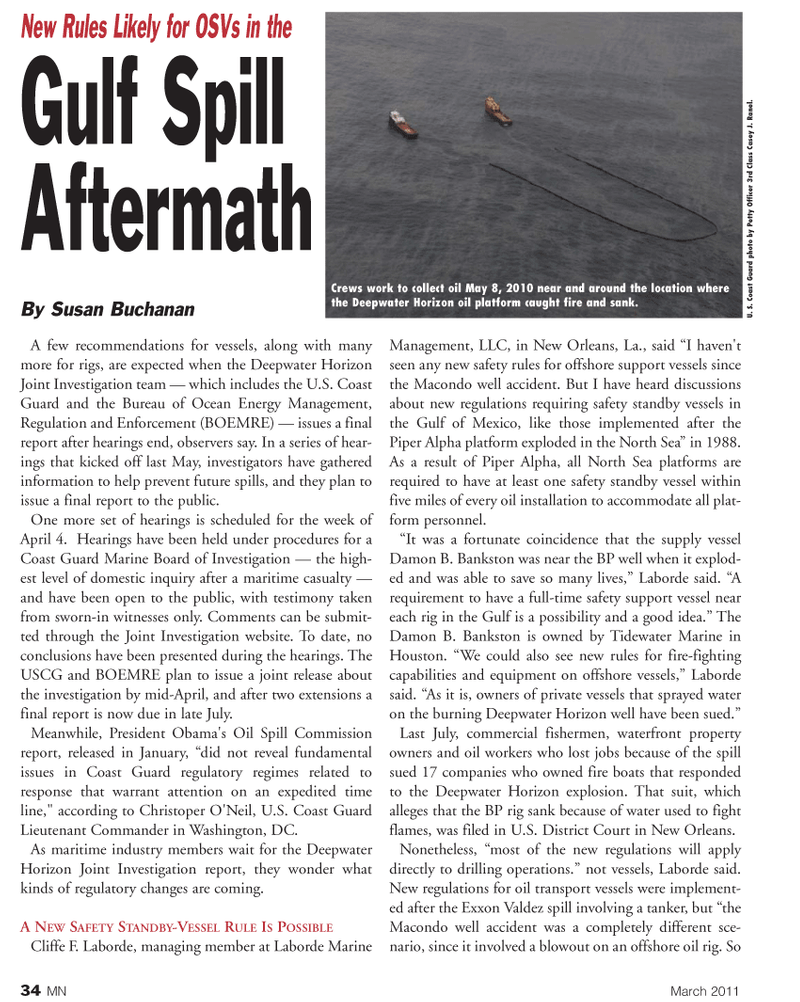
Page 34: of Marine News Magazine (March 2011)
Marine Training & Education Edition
Read this page in Pdf, Flash or Html5 edition of March 2011 Marine News Magazine
A few recommendations for vessels, along with many more for rigs, are expected when the Deepwater Horizon
Joint Investigation team — which includes the U.S. Coast
Guard and the Bureau of Ocean Energy Management,
Regulation and Enforcement (BOEMRE) — issues a final report after hearings end, observers say. In a series of hear- ings that kicked off last May, investigators have gathered information to help prevent future spills, and they plan to issue a final report to the public.
One more set of hearings is scheduled for the week of
April 4. Hearings have been held under procedures for a
Coast Guard Marine Board of Investigation — the high- est level of domestic inquiry after a maritime casualty — and have been open to the public, with testimony taken from sworn-in witnesses only. Comments can be submit- ted through the Joint Investigation website. To date, no conclusions have been presented during the hearings. The
USCG and BOEMRE plan to issue a joint release about the investigation by mid-April, and after two extensions a final report is now due in late July.
Meanwhile, President Obama's Oil Spill Commission report, released in January, “did not reveal fundamental issues in Coast Guard regulatory regimes related to response that warrant attention on an expedited time line," according to Christoper O'Neil, U.S. Coast Guard
Lieutenant Commander in Washington, DC.
As maritime industry members wait for the Deepwater
Horizon Joint Investigation report, they wonder what kinds of regulatory changes are coming.
A NEW SAFETY STANDBY-VESSEL RULE IS POSSIBLE
Cliffe F. Laborde, managing member at Laborde Marine
Management, LLC, in New Orleans, La., said “I haven't seen any new safety rules for offshore support vessels since the Macondo well accident. But I have heard discussions about new regulations requiring safety standby vessels in the Gulf of Mexico, like those implemented after the
Piper Alpha platform exploded in the North Sea” in 1988.
As a result of Piper Alpha, all North Sea platforms are required to have at least one safety standby vessel within five miles of every oil installation to accommodate all plat- form personnel. “It was a fortunate coincidence that the supply vessel
Damon B. Bankston was near the BP well when it explod- ed and was able to save so many lives,” Laborde said. “A requirement to have a full-time safety support vessel near each rig in the Gulf is a possibility and a good idea.” The
Damon B. Bankston is owned by Tidewater Marine in
Houston. “We could also see new rules for fire-fighting capabilities and equipment on offshore vessels,” Laborde said. “As it is, owners of private vessels that sprayed water on the burning Deepwater Horizon well have been sued.”
Last July, commercial fishermen, waterfront property owners and oil workers who lost jobs because of the spill sued 17 companies who owned fire boats that responded to the Deepwater Horizon explosion. That suit, which alleges that the BP rig sank because of water used to fight flames, was filed in U.S. District Court in New Orleans.
Nonetheless, “most of the new regulations will apply directly to drilling operations.” not vessels, Laborde said.
New regulations for oil transport vessels were implement- ed after the Exxon Valdez spill involving a tanker, but “the
Macondo well accident was a completely different sce- nario, since it involved a blowout on an offshore oil rig. So 34 MN March 2011
New Rules Likely for OSVs in the
Gulf Spill
Aftermath
By Susan Buchanan
Crews work to collect oil May 8, 2010 near and around the location where the Deepwater Horizon oil platform caught fire and sank.
U. S. Coast Guard photo by Petty Officer 3rd Class Casey J. Ranel.

 33
33

 35
35
